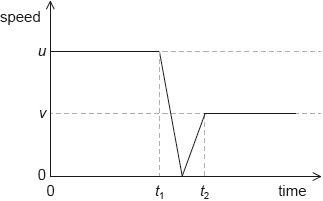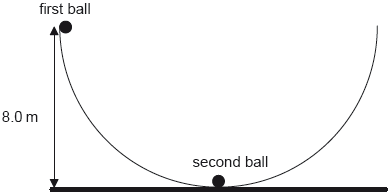DP Physics Questionbank

2.4 – Momentum and impulse
| Path: |
Description
Nature of science:
The concept of momentum and the principle of momentum conservation can be used to analyse and predict the outcome of a wide range of physical interactions, from macroscopic motion to microscopic collisions. (1.9)
Understandings:
- Newton’s second law expressed in terms of rate of change of momentum
- Impulse and force–time graphs
- Conservation of linear momentum
- Elastic collisions, inelastic collisions and explosions
Applications and skills:
- Applying conservation of momentum in simple isolated systems including (but not limited to) collisions, explosions, or water jets
- Using Newton’s second law quantitatively and qualitatively in cases where mass is not constant
- Sketching and interpreting force–time graphs
- Determining impulse in various contexts including (but not limited to) car safety and sports
- Qualitatively and quantitatively comparing situations involving elastic collisions, inelastic collisions and explosions
Guidance:
- Students should be aware that F = ma is equivalent of
only when mass is constant
- Solving simultaneous equations involving conservation of momentum and energy in collisions will not be required
- Calculations relating to collisions and explosions will be restricted to one-dimensional situations
- A comparison between energy involved in inelastic collisions (in which kinetic energy is not conserved) and the conservation of (total) energy should be made
Data booklet reference:
International-mindedness:
- Automobile passive safety standards have been adopted across the globe based on research conducted in many countries
Theory of knowledge:
- Do conservation laws restrict or enable further development in physics?
Utilization:
- Jet engines and rockets
Martial arts
- Particle theory and collisions (see Physics sub-topic 3.1)
Aims:
- Aim 3: conservation laws in science disciplines have played a major role in outlining the limits within which scientific theories are developed
- Aim 6: experiments could include (but are not limited to): analysis of collisions with respect to energy transfer; impulse investigations to determine velocity, force, time, or mass; determination of amount of transformed energy in inelastic collisions
- Aim 7: technology has allowed for more accurate and precise measurements of force and momentum, including video analysis of real-life collisions and modelling/simulations of molecular collisions
Directly related questions
- 16N.1.SL.TZ0.9: Two objects m1 and m2 approach each other along a straight line with speeds v1 and v2 as shown....
- 16N.1.SL.TZ0.5: An object, initially at rest, is accelerated by a constant force. Which graphs show the variation...
-
16N.1.SL.TZ0.8:
A ball of mass m strikes a vertical wall with a speed v at an angle of θ to the wall. The ball rebounds at the same speed and angle. What is the change in the magnitude of the momentum of the ball?
A. 2 mv sin θ
B. 2 mv cos θ
C. 2 mv
D. zero - 17M.1.SL.TZ2.8: A net force acts on a body. Which characteristic of the body will definitely change? A....
- 17M.1.SL.TZ1.15: Two pulses are travelling towards each other. What is a possible pulse shape when the pulses...
- 17M.1.SL.TZ1.9: An inelastic collision occurs between two bodies in the absence of external forces. What must be...
- 17M.1.SL.TZ2.9: A ball of mass 0.2 kg strikes a force sensor and sticks to it. Just before impact the ball is...
- 17M.2.SL.TZ1.1d.i: Calculate the impulse required from the net to stop the skier and state an appropriate unit for...
- 17M.1.HL.TZ1.7: A cyclist accelerates in a straight line. At one instant, when the cyclist is exerting a forward...
-
17M.1.HL.TZ2.7:
A stationary nucleus of polonium-210 undergoes alpha decay to form lead-206. The initial speed of the alpha particle is v. What is the speed of the lead-206 nucleus?
A. v
B. v
C. v
D. v
-
17M.2.SL.TZ1.1d.ii:
Explain, with reference to change in momentum, why a flexible safety net is less likely to harm the skier than a rigid barrier.
-
20N.1.SL.TZ0.9:
An object of mass strikes a vertical wall horizontally at speed . The object rebounds from the wall horizontally at speed .
What is the magnitude of the change in the momentum of the object?
A.
B.
C.
D.
-
20N.1.SL.TZ0.3:
An object of mass moving at velocity collides with a stationary object of mass . The objects stick together after the collision. What is the final speed and the change in total kinetic energy immediately after the collision?
-
20N.2.SL.TZ0.1a(iii):
Determine . State your answer to an appropriate number of significant figures.
-
20N.2.HL.TZ0.1a(iii):
Determine . State your answer to an appropriate number of significant figures.
- 17N.1.HL.TZ0.7: A toy car of mass 0.15 kg accelerates from a speed of 10 cm s–1 to a speed of 15 cm s–1. What...
- 17N.1.SL.TZ0.8: A moving system undergoes an explosion. What is correct for the momentum of the system and the...
-
17N.2.SL.TZ0.1c:
When the sledge is moving on the horizontal region of the snow, the girl jumps off the sledge. The girl has no horizontal velocity after the jump. The velocity of the sledge immediately after the girl jumps off is 4.2 m s–1. The mass of the girl is 55 kg and the mass of the sledge is 5.5 kg. Calculate the speed of the sledge immediately before the girl jumps from it.
-
17N.2.SL.TZ0.1d:
The girl chooses to jump so that she lands on loosely-packed snow rather than frozen ice. Outline why she chooses to land on the snow.
-
21M.2.SL.TZ1.1d.ii:
Player B intercepts the ball when it is at its peak height. Player B holds a paddle (racket) stationary and vertical. The ball is in contact with the paddle for 0.010 s. Assume the collision is elastic.
Calculate the average force exerted by the ball on the paddle. State your answer to an appropriate number of significant figures.
- 21M.1.HL.TZ1.6: Masses X and Y rest on a smooth horizontal surface and are connected by a massless spring. The...
- 21M.1.SL.TZ1.6: A ball undergoes an elastic collision with a vertical wall. Which of the following is equal to...
- 21M.1.SL.TZ1.9: An electron has a linear momentum of 4.0 × 10−25 kg m s−1. What is the order of magnitude of the...
- 21M.1.SL.TZ2.7: Two identical blocks, each of mass m and speed v, travel towards each other on a frictionless...
- 21M.1.SL.TZ2.8: A projectile is launched upwards at an angle θ to the horizontal with an initial momentum p0 and...
-
21M.2.SL.TZ2.1a:
The player’s foot is in contact with the ball for 55 ms. Calculate the average force that acts on the ball due to the football player.
- 18M.1.HL.TZ1.7: A stopper of mass 8 g leaves the opening of a container that contains pressurized gas.The stopper...
- 18M.1.SL.TZ1.6: Child X throws a ball to child Y. The system consists of the ball, the children and the Earth....
-
18M.2.SL.TZ1.1c.ii:
between B and C.
-
18M.1.SL.TZ1.9:
An object is moving in a straight line. A force F and a resistive force f act on the object along the straight line.

Both forces act for a time t.
What is the rate of change of momentum with time of the object during time t ?
A. F + f
B. F – f
C. (F + f )t
D. (F – f )t
-
18M.2.HL.TZ1.1b.i:
Determine the magnitude of the average resultant force acting on the block between B and C.
-
18M.2.SL.TZ1.1c.i:
between A and B.
- 18M.1.SL.TZ2.6: A ball of mass m is thrown with an initial speed of u at an angle θ to the horizontal as shown. Q...
-
18M.1.HL.TZ2.7:
A ball of mass m collides with a vertical wall with an initial horizontal speed u and rebounds with a horizontal speed v. The graph shows the variation of the speed of the ball with time.

What is the magnitude of the mean net force on the ball during the collision?
A.
B.
C.
D.
- 18M.1.SL.TZ2.5: The graph shows the variation with time t of the force F acting on an object of mass 15 000...
-
18M.2.SL.TZ2.1d:
A second identical ball is placed at the bottom of the bowl and the first ball is displaced so that its height from the horizontal is equal to 8.0 m.

The first ball is released and eventually strikes the second ball. The two balls remain in contact. Determine, in m, the maximum height reached by the two balls.
- 21N.1.SL.TZ0.9: A ball rolls on the floor towards a wall and rebounds with the same speed and at the same angle...
- 21N.1.HL.TZ0.6: A block rests on a frictionless horizontal surface. An air rifle pellet is fired horizontally...
-
21N.2.SL.TZ0.1d.i:
Determine the average force exerted on the floor by the ball.
- 21N.2.SL.TZ0.1d.ii: Suggest why the momentum of the ball was not conserved during the collision with the floor.
-
18M.2.HL.TZ2.1e:
A second identical ball is placed at the bottom of the bowl and the first ball is displaced so that its height from the horizontal is equal to 8.0 m.

The first ball is released and eventually strikes the second ball. The two balls remain in contact. Determine, in m, the maximum height reached by the two balls.
-
18M.2.SL.TZ1.1b.i:
Determine the magnitude of the average resultant force acting on the block between B and C.
-
18M.2.HL.TZ1.1c.i:
between A and B.
-
18M.2.HL.TZ1.1c.ii:
between B and C.
- 18N.2.HL.TZ0.3a: Define impulse.
-
18N.2.HL.TZ0.1a:
Determine the initial acceleration of the spacecraft.
-
18N.2.HL.TZ0.3b.ii:
The egg comes to rest in a time of 55 ms. Determine the magnitude of the average decelerating force that the ground exerts on the egg.
-
18N.1.SL.TZ0.9:
A ball of mass m collides with a wall and bounces back in a straight line. The ball loses 75 % of the initial energy during the collision. The speed before the collision is v.
What is the magnitude of the impulse on the ball by the wall?
A.
B.
C.
D.
-
18N.2.SL.TZ0.1a:
Determine the initial acceleration of the spacecraft.
- 18N.2.SL.TZ0.3b: Explain why the egg is likely to break when dropped onto concrete from the same height.
-
18N.2.SL.TZ0.3a:
Determine the magnitude of the average decelerating force that the ground exerts on the egg.
- 18N.2.HL.TZ0.3b.iii: Explain why the egg is likely to break when dropped onto concrete from the same height.
- 22M.1.SL.TZ1.9: Two trolleys of equal mass travel in opposite directions as shown. The trolleys collide...
- 22M.2.SL.TZ1.1a: Outline two differences between the momentum of the box and the momentum of the load at the same...
- 22M.1.HL.TZ1.9: Two bodies each of equal mass travelling in opposite directions collide head-on. What is a...
-
22M.2.SL.TZ2.1b.ii:
Show that the tension in the rope is about 5 kN.
-
22M.2.SL.TZ2.1a:
Outline why a force acts on the airboat due to the fan blade.
-
22M.2.HL.TZ2.1b.ii:
Show that the tension in the rope is about 5 kN.
-
22M.2.HL.TZ2.1a:
Outline why a force acts on the airboat due to the fan blade.
-
19M.2.HL.TZ2.1ai:
Calculate the average force exerted by the racquet on the ball.
- 19M.2.SL.TZ1.5b: Show that the collision is inelastic.
- 19M.2.SL.TZ1.5a: Calculate the speed of the combined masses immediately after the collision.
- 19M.1.HL.TZ2.6: The graph shows the variation of momentum with time for an object. What net force acts on the...
- 19M.1.SL.TZ2.8: A table-tennis ball of mass 3 g is fired with a speed of 10 m s-1 from a stationary toy gun of...
- 19M.2.HL.TZ1.6b.ii: Show that the collision is inelastic.
- 19M.2.HL.TZ1.6b.i: Calculate the speed of the combined masses immediately after the collision.
-
19M.2.SL.TZ2.1ai:
Calculate the average force exerted by the racquet on the ball.
-
19N.2.SL.TZ0.1a:
Calculate the speed of the ball as it leaves the racket.
-
19N.2.SL.TZ0.1b:
Show that the average force exerted on the ball by the racket is about 50 N.
-
19N.2.SL.TZ0.7b(ii):
Calculate the ratio .
